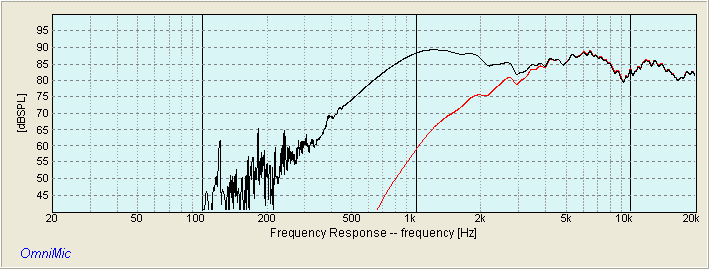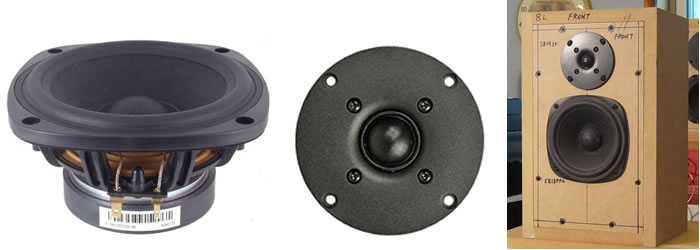|
Sparrow-19ST
SB Acoustics SB13PFC25-08 with SB19ST-C000-4 Tweeter
Active BiAmped
The Sparrow-19ST is my fourth attempt with the SB Acoustics 5″ plastic frame SB13PFC25-08 midwoofer. In all my previous designs, I felt the crossovers could have been better. This time round, I decided to mate the SB13PFC with a budget tweeter by the same manufacturer, a 3/4′” soft dome SB19ST-C000-4. Hopefully, she will be a better match.
A major difference between the Sparrow-19ST and those before is that this design is a Sealed Box. After working with three bass reflexes, I believe the SB13PFC25-08 is better suited as a midrange in a 3-way or in this case, as a satellite.
As before, the Sparrow-19ST is driven by my Synergy biamp amplifier kit. The internal precision crossover is set at 3.0kHz. This is the lowest I usually go with 3/4″ tweeters. Anything less and they sound stressed.
All measurements are with the microphone at 24 ins, tweeter axis. Impulse Window = 5msec. No Smoothing applied. Frequencies below 500Hz are in Nearfield.
Frequency Response of SB13PFC25-08
Sealed Box = 8 liters. Baffle Width = 9″
Fig 1 – Black plot=RAW. Blue Plot=3.0kHz LPF @ 18dB/oct
Fig 1 shows the RAW response (Black plot) of the SB13PFC25. The Blue plot is with a LPF of 3kHz at 18dB/oct.
Frequency Response of SB19ST-C000-4 Tweeter
Fig 2 – Black plot=RAW. Red Plot=3.0kHz HPF @ 18dB/oct
Fig 2 is the RAW response (Black plot) of the SB19ST tweeter. The Red plot is with a HPF of 3kHz at 18dB/oct. The tweeter is surface mounted, hence the two dips, one at 9kHz and the other at 18kHz. The response will be smoother once the tweeter is flush mounted. What is more important is the smooth slope in the roll-off.
Crossing the SB13PFC25-08 with SB19ST-C000-4 Tweeter
fc = 3.0kHz • 18dB/oct
Fig 3 – Blue plot=SB13PFC25-08. Red plot=SB19ST-C000-4
Fig 3 shows the SB13PFC25 crossing over to the SB19ST. Acoustically, they cross at 3kHz, which is promising. This indicates that I won’t have to “fight” the drivers when I work on the passive crossover.
Sparrow-19ST Frequency Response
Fig 4 – Summed Response with SB19ST-C000-4 wired in Reversed Phase
Fig 4 is the summed response of the SB13PFC25 with the SB19ST wired in reversed phase. I’m encouraged that the crossover region is smoother than the previous Sparrows.
Sparrow-19ST Crossover Null
Fig 5 – Crossover Null when SB19ST-C000-4 is wired In-Phase
Fig 5 is with SB19ST re-wired to normal phase. The Violet plot shows the phasing of the two drivers are slightly off. I’m confident that I can improve on this with a passive crossover.
Sparrow-19ST Cumulative Spectral Decay (CSD)
Fig 6 – Rise Time = 0.10 msec. Window = 1.3 msec ( 769Hz ). Time Range = 1.5 msec
Sparrow-19ST Toneburst Energy Storage (TES)
Fig 7 – Summed Response of SB13PFC25-08 with SB19ST-C000-4 in Reversed Phase
The Sparrow-19ST is quite clean. The Waterfall plot in Fig 6 shows some minute artifacts from 2kHz~5kHz. The same artifacts are seen in Fig 7 as light blue slices. The Spectrogram in Fig 8 shows the artifacts are below 2msec. That’s impossible to detect audibly.
Sparrow-19ST Spectrogram
Fig 8 – Sparrow-19ST Wavelet
Sparrow-19ST Harmonic Distortion
Fig 9 – Red plot = 2nd Harmonic. Violet plot = 3rd Harmonic
Setting Up the Sparrow-19ST 2.1
Sharing the same setup as the Solitaire 2.1 audition, the Sparrow-SB19ST 2.1 is actively tri-amped. The Synergy amps drive the Sparrow-19ST satellites while another amplifier drives the Albatross. The Albatross is electronically Low Pass at 300Hz at 24dB/oct to ensure that no midrange bleeds into the midrange.
How’s the Sound?
When I first heard the Sparrow-19ST, the tweeter sounded harsh. I thought perhaps it’s a QC issue in manufacturing. Nonetheless, I persevered. As I had hoped, the harshness vanished after a few days.
With the Sparrow-19ST now broken in, it’s time for some serious listening. To test the crossover, I played Fool for Love by Amanda McBroom. This is one of those tracks that her voice will sound excessively sibilant if the crossover is bad. The Sparrow-19ST passed with flying colors.
Next is Nana Mouskouri. If the speaker is not properly designed, she’ll sound awful. I played Only Love, Amazing Grace, Ave Maria and many more. The Sparrow-19ST performed flawlessly.
All in, I’m more than satisfied with the Sparrow-19ST. For less than $50 per speaker (SB13PFC25-08=$23.30, SB19ST-C000-4=$19.80), the sound quality is impressive. The reproduction is accurate and neutral. The Sparrow-19ST definitely deserves a passive crossover.
Next > Sparrow-19ST ver2 |










